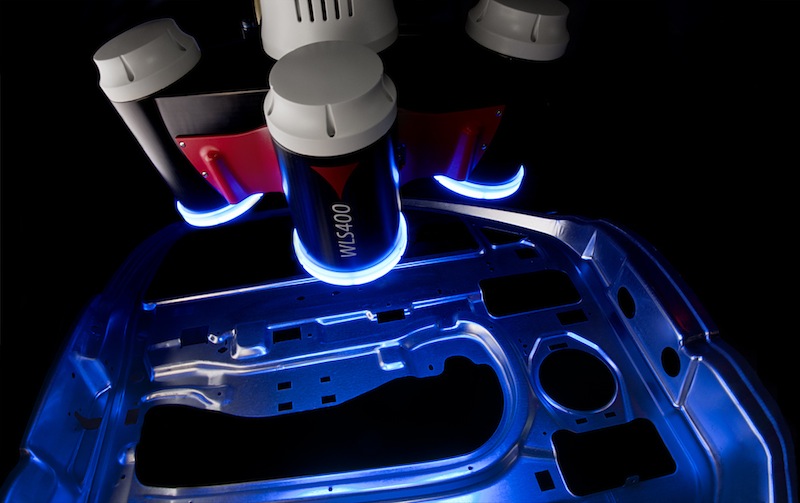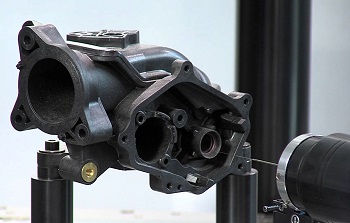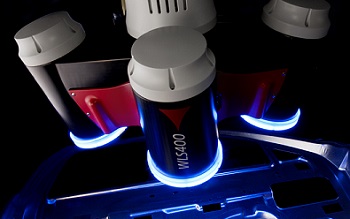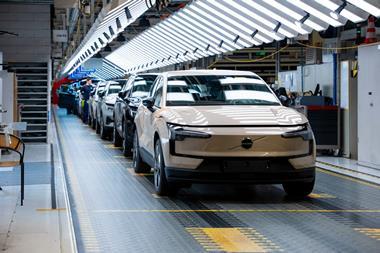The latest multi-sensor metrology devices can help Quality Control to accelerate throughput while meeting zero-defect customer demands - as well as tackling the most challenging automotive applications

Both tactile and optical measurement methods have their advantages, but thanks to their complementary nature, the combination of the two often offers better data than either in isolation. Indeed, many metrology equipment manufacturers have taken the concept a step further by adding a third sensor, namely laser or ‘white light’, to single-platform solutions.
It is fair to say that multi-sensor measurement technology brings into view some exceptionally challenging applications within the automotive industry. For example, with cylinder heads, a number of complex measuring tasks have long perplexed quality engineers seeking efficient yet accurate and reliable metrology processes.
Consider the valve seat, which typically requires its angle and position to be measured in relation to the guide stem, a task far more easily contemplated than undertaken. For a start, valve-seat lands are tiny and often conical in shape. With this in mind, a conventional coordinate measuring machine (CMM) is not only unable to obtain enough points to generate an accurate data set of the cone, but also struggles to gain sufficient access.
Flexible measurement
Traditionally, most automotive manufacturers have turned to dedicated gauging solutions. However, this is not only an expensive practice, but also an inflexible one. As a consequence, increasing numbers of drivetrain makers are adopting multi-sensor measurement.
In the cylinder-head application already described, a laser probe on an OGP multi-sensor measurement system is able to scan the face of the valve seat in several positions to obtain an accurate cone measurement. A camera probe can then be used to measure the form of the hole in the seat, while a touch probe can be deployed to reach into the valve stem. All the probes switch seamlessly on a single platform, ensuring a fast process. In fact, programming and GR&R (gauge repeatability and reproducibility) can be completed in around three hours for such applications. Compare this with the weeks, if not months, required to design, manufacture and commission a dedicated gauge set.

OGP machines also make it possible to communicate with a PLC to load and unload components on a production-line basis to suit the workflow demands of the automotive sector. This is important; although using the measurement technologies available in a multi-sensor system can improve efficiencies through higher throughputs and lower scrap rates, the system’s position in the manufacturing workflow must be considered to exploit the available benefits to their maximum.
Aside from cylinder heads, the entire automotive drivetrain area is epitomised by tricky measurements best conducted using multi-sensor measurement. Other parts that lend themselves to this technology include pistons, piston rings, con-rod bearing shells and piston swirl chambers, to list but a few.
Reliable and cost-effective solutions
Clearly, the latest multi-sensor measuring technologies have much to offer the discerning quality engineers sourcing efficient, reliable and cost-effective ways to measure complex automotive parts. In combination with video and laser probes, a full suite of Renishaw probes can be accommodated on OGP machines, including SP25 scanning probes and PH10 single-point, touch-trigger variants. The former automatically acquire data points between user-defined start and end points – regardless of surface complexity – even when the system has no prior knowledge of the path between those points, while the latter facilitate enhanced access for difficult-to-reach part features. All probes are calibrated with each other and work in the same frame of reference to ensure ease-of-use for system operators.
Among the users of OPG multi-sensor technology is Southend, UK-based CS Precision, where a SmartScope 500 CNC travelling bridge, 3D measuring centre with a fourth rotary axis has enabled the company to increase its multi-feature measuring volume to 500mm x 450mm x 200mm. CS Precision’s OGP machine has proven able to perform the same tasks within 30 minutes that would take a CMM an hour or more.
 The VideoCheck multi-sensor measuring device from Werth is helping to verify tooling at Kleiner Stanztechnik, Germany
The VideoCheck multi-sensor measuring device from Werth is helping to verify tooling at Kleiner Stanztechnik, Germany CS Precision says the success of the OGP machine is helped by the stability of the software, which is critical when having to check workpieces with around 150 dimensions. Due to the complexity of some parts, the measurement routine will also require four or five different datum or reference points. However, using the new machine, this can be achieved without moving the part.
Early defect detection
The story is similar at Kleiner Stanztechnik of Phorzheim, Germany, where a Werth VideoCheck HA multi-sensor measuring machine helps to verify the tooling required to manufacture an array of micro-stamped components, springs, snap panels and even populated, stamped mesh parts for automotive customers.
The company tasks itself with detecting any deviations from the specification as early as possible, and not just once the tool is online and ready to be run. Therefore, Kleiner checks the shape of electrode, punch and die inserts very carefully while they are being manufactured.
The VideoCheck HA 400, with a measurement range of 400mm x 400mm x 200mm, is located in the tool shop. The tolerances on tools and tool components are in the micron range, while on the stamped components they are in the range of hundredths of a millimetre. The precision of measurement (expressed as the measuring uncertainty) should always be an order of magnitude – at least a factor of five – better than the feature’s tolerance.
To follow this rule and therefore provide meaningful measurement results to the manufacturing or development departments for corrective actions, Kleiner decided on the HA (high accuracy) version of the Werth VideoCheck. The HA has a stable mechanical design made of granite, with special air bearings, extremely high-resolution scales, and design measures to prevent hysteresis. This allows measurement results with an uncertainty of less than 1µm, and reproducibility of a few tenths of a micron.
The measurement technicians at Kleiner decided on a package of various sensors to equip the machine: the image-processing sensor with integrated laser sensor, as well as the Nano Focus Probe (NFP) and the patented Werth Fibre Probe (WFP). An additional rotary axis allows the workpiece to be rotated to any position; the ability to perform rotary movements means that components can be scanned with the NFP from any angle.
Measuring roughness and waviness
Another interesting sensor development to appear on the market recently is the Zeiss Rotos. This device enables users to measure both the roughness and waviness of powertrain components (in compliance with recognised industry standards) on a single CMM. It is therefore no longer necessary to transfer powertrain parts to a dedicated surface-measurement instrument.
Instead of clamping the workpiece on a contact stylus instrument, Zeiss Rotos is used via the stylus changer interface on the probe of the CMM – under full CNC control. The advantage is that this takes just a few seconds compared with several minutes previously. Furthermore, the sensor features a rotating/tilting axis; the rotary axis can turn a full 360°, while the sensor can be tilted perpendicularly via the tilt axis to provide a range of 160°.
Importantly, measurement data from the Zeiss Rotos is transmitted via Bluetooth to the analysis computer. The
data is then imported into Zeiss Calypso software and can be exported with other measurement data in a
common report.
Sensor technology is driving the capability of modern measurement devices, a statement of fact that can be verified by Hexagon Metrology, which has developed an application to detect the quotas on car bodies and other parts with the aid of robotic technology, specifically that of Comau. The solution is rather simple in that Hexagon has applied a photogrammetry sensor to a robot that operates directly inside the line.
Until now, companies could typically perform quality checks and measurements on car bodies, body panels or body parts in one of two ways. The first was by using objects such as caliper gauges or perception tunnels (tunnels where vision systems are positioned). For more accurate and precise measurements, they could use a measuring machine with a horizontal arm (which doubles in the case of car bodies) through which pieces are measured precisely in both a tactile and optical way. The problem with these solutions, however, is the time required; they are too slow for highly repetitive automotive lines.
To address this issue, Hexagon Metrology decided to rely on robotics. However, although robots are fast, they are not capable of ensuring the required accuracy for the measurement of a car body that has tolerances of only of a few tenths of a millimetre.
 Hexagon has developed a white-light system which takes 3D photographs using three lenses in combination
Hexagon has developed a white-light system which takes 3D photographs using three lenses in combinationThe speed of the robot is critical at this stage. The machine, in fact, moves quickly from one point to the other of the trajectory, which is set to capture all the images needed to reconstruct the object. As such, it collects a large amount of data in just a few moments. Importantly, the computer receiving the data can exclude redundant or unnecessary images and reconstruct the piece accurately and quickly.
The solution clearly solved the question of speed, but precision was still an issue. So, for each measurement cycle, the sensor/robot system was recalibrated with reference calipers that had been placed previously in the measurement station and combined with others positioned on the car body. In this way, the system adapts and resets based on each incoming body, avoiding the risk of an inaccurate image and consequent inaccurate measurement. In addition, the system is able to take pictures with an exposure time of a hundredth of a second, which means that the overall picture is accurate and avoids any risk of blurring.
The system, designed by Hexagon Metrology with the help of Comau robots, performs all the necessary activities in just 60 seconds. The flexibility of the robot’s movements put the sensor into positions that were historically almost impossible to achieve. Hexagon is currently installing this solution in Fiat Group factories.




































